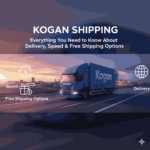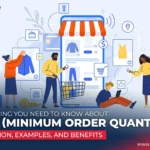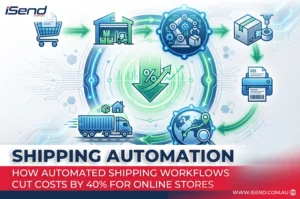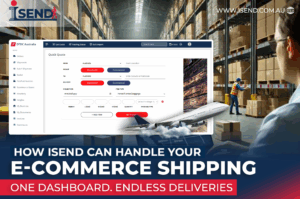Australia’s e-commerce market is booming, ranking 14th globally, above countries with far larger populations like Brazil and Italy. With projected revenues of USD 50.7 billion in 2025 and expected to reach USD 69.5 billion by 2029 (CAGR of 8.2%), digital retail is firmly embedded in consumer behavior.
As online shopping rapidly grows, seamless logistics is a necessity—not just for delivery speed but also to support growing cross-border e-commerce. Businesses must optimize logistics to remain competitive across Australia’s vast geography and international connections.
This guide breaks down everything you must know—logistics components and local solutions—to remain competitive in the dynamic Australian market.
Key Takeaways
- E-commerce logistics involves managing stocks, warehousing, shipping, and returns.
- High speed of booking and ease of returns increase consumer loyalty.
- Australia is a nation whose geography requires localised logistics.
- The HS Tariff Codes are essential factors in compliance with cross-border ecommerce logistics.
- Trustworthy service providers like iSend facilitate the process of e-commerce logistics.
What Is E-Commerce Logistics?
E-commerce logistics refers to the end-to-end process of storing, handling, and delivering online orders. It starts when a product is listed online and continues through distribution and possible returns. Logistics in e-commerce involves ensuring that customers are adequately satisfied through optimal costs in everything related to managing inventory in warehouses and timely shipment.
This process is vital in Australia, which is quite large and has a scattered population. Effective e-commerce logistics systems are crucial to accessing customers in both urban and rural areas.
Key Components of E-Commerce Logistics
The success of e-commerce logistics relies upon several interdependent elements that cooperate to provide seamless processes between clicking and reaching the doorstep. Every component, including inventory, returns, and so on, is essential in satisfying customer needs and demands, minimising prices, and enhancing order accuracy.
Let’s explore the key components that shape a successful e-commerce logistics strategy.
Inventory Management
Effective inventory control can be used to avoid stockouts and excess inventory. Real-time inventory syncing tools such as Shopify or NetSuite will give a more accurate forecast, and better decisions can be made. Inventory mismanagement accounts for 11% of lost sales in Australian e-commerce.
Order Fulfillment
This includes receiving, picking, packing, and shipping customer orders. The automated order fulfillment processes enable a shorter order processing period with reduced human error. Distribution centres near the centres of big cities such as Sydney and Melbourne are strategically located for same-day or next-day services.
Warehousing
Effective warehousing will lessen the lead time and enhance the speed of delivery. The high-tech solutions offered by temperature-controlled storage, intelligent racking, and 24/7 access help improve ecommerce logistics and fulfillment results.
Packaging
Beyond protecting items during transit, packaging impacts branding and customer satisfaction. Recyclable or sustainable packaging is becoming a must-have, as 72% of consumers prefer eco-friendly packaging.
Shipping
Shipping can be one of the most complex aspects of logistics for e-commerce. Australia Post, Sendle, and CouriersPlease are among the top choices. Multiple delivery options—standard, express, click—and—collect—enhance customer satisfaction.
Returns Management
A streamlined return policy increases consumer trust. According to Australia Post, 67% of shoppers say an easy return process influences their purchase decision. Efficient reverse logistics helps retain customers and reduce losses.
Why E-Commerce Logistics Matters
Logistics is no longer a backend customer service: customer experience, brand loyalty, and profitability are directly related. The e-commerce logistics cycle must be sensitive to customers’ immediate speed, tracking, and convenience requirements.
A poor logistics e-commerce strategy will result in a rise in cart abandonment rates, low ratings, and high costs. On the contrary, the ease of operation preaches a surge in brand popularity and repeat demand.
The e-commerce market in Australia is very competitive. The ecommerce logistics meaning evolves as new technologies enter the market.
Most companies require continuous development of their e-commerce logistics solutions to meet the competition and customers’ expectations.
Logistic Solutions for E-Commerce Businesses
There are a variety of ecommerce logistics solutions that businesses may avail themselves of, based on their sizes, budgetary constraints, and expansion levels:
- Third-Party Logistics (3PL)
Domestic storage, packaging, and shipping solution providers can be contracted. They are best suited for scaling up operations without investing in infrastructure.
- Drop Shipping
The inventory is unnecessary because the products move straight from the supplier to the client.
- In-house Fulfillment
It enables businesses to have control, but can become complicated and expensive over time.
It is crucial to have international carriers and compliance systems as partners to run cross-border e-commerce logistics. Decentralised fulfilment helps stay competitive, guaranteeing easy customs clearance and delivery to any last-mile destinations, be it New Zealand or Southeast Asia.
Difference Between Logistics and E-Commerce
Often used interchangeably, logistics and e-commerce differ in scope. E-commerce refers to the buying and selling of goods online, while logistics, on the other hand, covers the physical movement, storage, and handling of these goods.
In simpler terms:
- E-commerce is the storefront and digital customer interaction.
- Logistics is the backend system that ensures orders are fulfilled efficiently.
Both areas must collaborate in e-commerce logistics to create seamless customer experiences. Proper alignment reduces delivery times, boosts customer satisfaction, and drives long-term growth.
Neglecting either side can create bottlenecks, leading to missed sales and poor customer retention.
The Role of HS Tariff Code in E-Commerce Logistics (Australia)
In cross-border ecommerce logistics, accurate HS Tariff Codes are vital for smooth customs clearance and cost management.
Here’s why they’re essential for Australian businesses:
- Product Classification
HS Codes systematically classify products for international trade, ensuring clear identification across borders.
- Customs Compliance
The Australian Border Force (ABF) mandates correct codes for imports and exports. Errors can lead to delays, fines, or confiscated shipments.
- Duty and Tax Calculation
HS Codes determine applicable import duties and GST, which are crucial for cost forecasting.
- Faster Clearance
Proper classification speeds up border processes and avoids supply chain disruptions.
- Tools for Accuracy
Platforms like ABF’s Tariff Classification Tool help e-commerce businesses find the correct code, improving compliance and efficiency.
Using the correct HS Code streamlines international trade and reduces risk.
How iSend Supports Efficient E-Commerce Logistics
iSend is a trusted name in ecommerce logistics solutions designed specifically for Australian businesses. From small online stores to large-scale enterprises, iSend offers comprehensive services to streamline logistics and improve customer satisfaction.
Here’s how iSend makes a difference:
- Advanced Tracking Systems
Real-time shipment tracking increases visibility, reduces friction and builds trust through transparency.
- Multiple Courier Integrations
Seamless integration with major carriers like Australia Post, Aramex, and DHL ensures broad delivery coverage and flexibility.
- Automated Fulfillment
Smart workflows speed up order processing, reduce errors, and cut labour costs, improving fulfillment efficiency.
- Customs and HS Code Expertise
iSend helps manage cross-border e-commerce logistics by ensuring accurate HS code documentation and smooth customs clearance.
- Local Market Knowledge
With deep insights into Australian geography and consumer behaviour, iSend tailors its logistics ecommerce strategy to match unique market needs.
This tailored approach helps reduce RTOs, boost customer satisfaction, and drive long-term business growth.
Conclusion
In Australia’s rapidly evolving online marketplace, mastering ecommerce logistics is crucial. From managing inventory to understanding HS codes, every step in the ecommerce logistics process affects your bottom line and customer satisfaction.
Investing in efficient systems, partnering with innovative logistics providers like iSend, and staying updated on regulations will help you overcome ecommerce logistics challenges and outpace the competition.
As the e-commerce space becomes more competitive, those prioritising seamless e-commerce logistics and fulfillment will survive and thrive.








